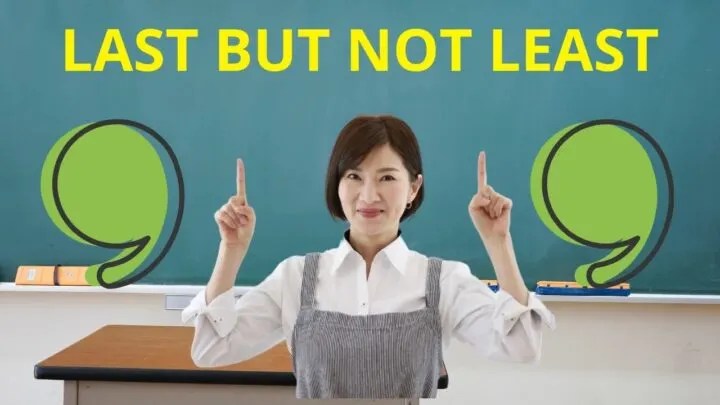A fixed phrase or expression is a set of words that are always used together to convey a certain concept.
“Last but not least” is one of those types of phrases.
Those four words are used to express the idea that although you are mentioning something last, that placement does not mean that it is less important than what you have already mentioned.
Occasionally, people might play with the phrase a little bit, adding words for emphasis, such as “last but by no means least” or “last but certainly not least.”
Despite those little variations, the phrase is always punctuated in the same way.
Do you need a comma after “last but not least”?
You need a comma after “last but not least” because it is nearly always a nonessential phrase. However, there are a few limited circumstances in which it acts as an essential phrase in a sentence, and when this happens, it should not have a comma after it.
“Last but not least” as an introductory phrase
One of the most common places to see “last but not least” is at the beginning of a sentence.
The rule says that an introductory phrase should be followed by a comma, so this is one reason a comma comes after it.
However, it is also a nonessential phrase, and this rule about needing to be followed by a comma because it is a nonessential phrase holds wherever it comes in the sentence.
Therefore, if it is easier for you to just remember that one rule about the phrase, that will work!
Here are three sentences that start with “last but not least”:
Last but not least, we want to introduce the great magician Mario!
Last but not least, students should return to the campus after lunch is over.
Another place where it’s common to see “last but not least” as an introductory element is in the second part of an independent clause:
Sonia will do a talk at four, and Priya will follow her. Then Melissa will give a short lecture, and last but not least, Eric will make some closing remarks.
“Last but not least” as part of a list
Another place where it is common to see the phrase “last but not least” is in a list just before the last item.
As a nonessential phrase, meaning it could be removed from the sentence without changing it, it needs to be set apart from the rest of the sentence with commas.
Here are two examples:
The winners are Harry, Joann and, last but not least, Franklin.
Make your bed, scrub the bathtub and, last but not least, put the trash out.
“Last but not least” as an essential phrase
It is not common, but you will occasionally see “last but not least” used as an essential phrase.
In other words, if you took it out of the sentence, the sentence would not make sense.
When that happens, you should not put a comma after the phrase.
Here are two sentences in which “last but not least” is an essential phrase:
Showing that you understand how it all works is the last but not least phase of training.
The last but not least of the competitors arrived just before the race began.
Be careful about assuming that “last but not least” at the beginning of a sentence is always part of an introductory phrase and thus always is followed by a comma!
Note that in the example below, it actually is the subject of the sentence and therefore an essential phrase.
Last but not least was the information about how to unlock the door.

Hey fellow Linguaholics! It’s me, Marcel. I am the proud owner of linguaholic.com. Languages have always been my passion and I have studied Linguistics, Computational Linguistics and Sinology at the University of Zurich. It is my utmost pleasure to share with all of you guys what I know about languages and linguistics in general.

